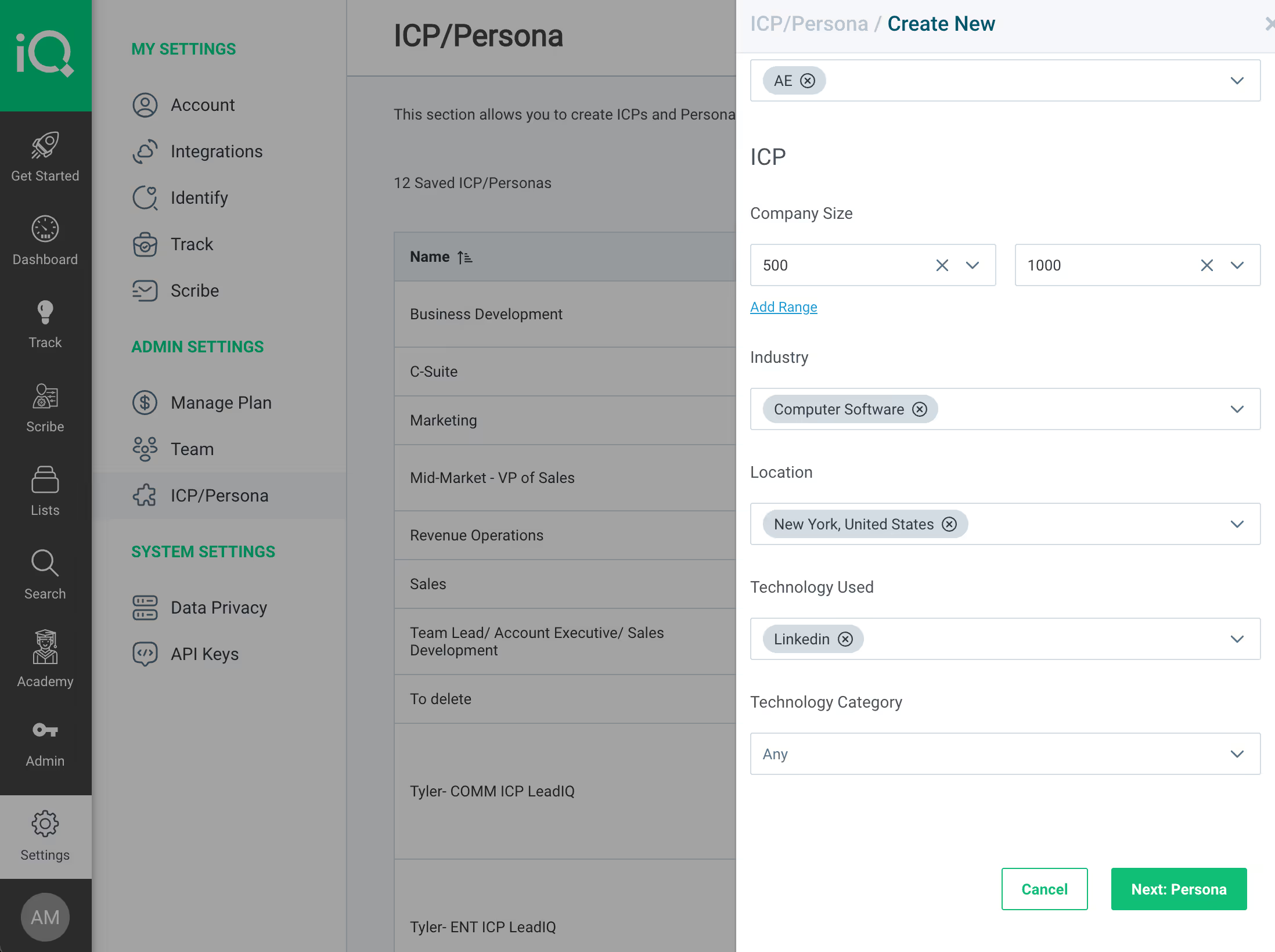Ready to create more pipeline?
Get a demo and discover why thousands of SDR and Sales teams trust LeadIQ to help them build pipeline confidently.



Understanding and focusing on your ICP ensures that your sales and marketing efforts are directed toward prospects most likely to convert, leading to higher conversion rates and better ROI.

A well-defined ICP includes firmographics, technographics, and behavioral attributes, enabling sales teams to align their strategies with the specific needs and preferences of ideal customers.

Incorporating ICPs into cold outreach allows for personalized messaging, enhancing relevance and engagement with prospects.
Get a demo and discover why thousands of SDR and Sales teams trust LeadIQ to help them build pipeline confidently.
For B2B SaaS sales and marketing teams, reaching your full potential is only possible when you understand your ideal customer profile (ICP) on the deepest level.
At a high level, an ICP serves as a blueprint that guides sales and marketing teams toward the prospects that are most likely to convert into satisfied customers. Instead of throwing your cold outreach efforts out into the void and crossing your fingers hoping for a response, narrowing your focus on targets that best fit your ICP — and the customer personas within that ICP — increases your chances of success because these folks are highly likely to be interested in your offerings compared to run-of-the-mill prospects.
If you’re looking to learn more about ICPs, you’ve come to the right place. Read on to learn more about what ICPs and customer personas are, how to establish them, what you should do once you’ve defined your ICP, and how sales reps can incorporate ICPs and personas into cold outreach efforts.
The ideal customer profile refers to a detailed description of the characteristics and attributes the perfect customer of your business is likely to possess. For B2B SaaS organizations, this profile typically depicts a niche business segment and can include demographic, firmographic, geographic data, and other relevant criteria that sales and marketing teams can use to spend more time targeting the right accounts.
To develop an even more targeted go-to-market strategy, many organizations create customer personas. Customer personas are fictional archetypes that represent the key stakeholders within a specific ICP. This framework allows organizations to speculate which individuals at an organization are most likely to be the decision maker or push a deal forward.
By defining the ICP and customer personas for sales, businesses can focus their outreach efforts on the proper audience at both the account and stakeholder level, leading to higher conversion rates, increased customer satisfaction, and improved ROI.
In other words, the ICP serves as a guiding framework for aligning sales and marketing strategies with the needs and preferences of your most valuable existing customer accounts and users in hopes of attracting new customers that are similar.
Before starting their cold outreach, sellers should be deeply familiar with each of these core components of an ICP:
Sales teams also need to be intimately familiar with customer personas, which are based on these characteristics, before crafting their cold emails:
%2520(1).avif)
While both ICPs and personas are used in marketing and sales efforts, they serve distinct purposes.
On one hand, an ICP for sales defines the characteristics and attributes of the ideal customer at an organizational level, providing a broad overview of the target audience. This might include technology companies with between 100 and 500 employees and $20 and $50 million in revenue each year, for example.
On the other, a persona is a fictional character that embodies the traits and behaviors of a specific segment within the target audience, offering a more detailed and personalized understanding of individual customer types and their unique needs and preferences. For example, a software company might target several personas: the C-suite, line of business managers, and end users.
Does your organization have documented ICPs? If you’re not sure, reach out to your product marketing team or an internal marketing leader; either should be able to point you in the right direction.
If your organization doesn’t have ICPs — or you want to improve whatever you have currently — follow these steps to establish a robust ICP for your business.
Stressing the importance of sales, marketing, and product alignment is crucial when creating an ICP because it ensures a unified approach across the organization. By aligning these departments up front, companies can develop a comprehensive understanding of their target audience, resulting in more effective strategies and messaging. On the flipside, when these teams aren’t aligned, it’s easy for critical characteristics to slip through the cracks.
While sales teams provide valuable insights into customer needs and pain points, marketing offers expertise in segmentation and messaging. Product teams complement these capabilities by contributing insights into product-market fit and feature development.
When all of these departments collaborate closely, they can collectively refine the ICP to accurately reflect the ideal customer. This, in turn, leads to better-targeted campaigns, improved customer engagement, and ultimately higher conversion rates and revenue growth.
Creating an ICP requires teams to conduct market research. Doing so provides valuable insights into market dynamics, customer behavior, and emerging trends. By thoroughly researching the market, businesses can gain a deep understanding of their target market — including industry trends, market segments, and the overall competitive landscape.
Market research helps identify opportunities for growth, assess market saturation, and uncover unmet needs or underserved segments. By leveraging these data-driven insights, your team can develop a more accurate and informed ICP that aligns with market trends and customer preferences.
Altogether, this helps your business make more strategic decisions while figuring out how to position itself in the marketplace, leading to improved targeted, more relevant messaging, and more conversions.
Customer analysis helps businesses gain deeper insights into their existing customer base — something that’s critical when building an ICP. By analyzing demographics, firmographics, technographics, and psychographics, you can identify common characteristics, preferences, and pain points among your most valuable customers.
Simply put, customer analysis helps businesses understand who their ideal customers are, what motivates them, and how they make purchasing decisions. This information can be used to create a detailed and accurate ICP that reflects the needs and preferences of your target audience.
Add it all up, and customer analysis makes it easy to target the right audience with the right message at the right time — leading to more effective cold outreach outcomes.
Last but not least, you need to conduct a competitive analysis to learn more about market trends, competitor strategies, and potential gaps in the market while devising your ICP. By evaluating competitors’ offerings, positioning, and customer base, your team can identify areas for differentiation and capitalize on those opportunities.
Competitive analysis helps organizations understand the business landscape, assess market saturation, and identify areas of growth. Using these insights, you can tailor your ICP to address unmet needs and further improve your positioning in the marketplace.
Bottom line? By conducting a competitive analysis, you can refine your ICP even more, leading to more success with cold outreach.
You’ve done the work, and you have a crystal-clear idea of what your ICP looks like. That’s great news! Now, it’s time to make sure every rep in your organization knows your ICP like the back of their hand. Here’s how to make that happen:
To apply your ICP to your cold outreach messaging, start by researching your target audience and understanding their needs, preferences, and challenges. From there, craft personalized messages that address these specific pain points and highlight the unique value proposition your product or service offers to solve their problems.
Be sure to use language and tone that aligns with the communication style of your ideal customers and emphasize how your solutions can help them. When you align your messaging with your ICP up front, it’s much easier to create more relevant and compelling cold outreach campaigns that truly resonate.
At the same time, it’s also much easier to figure out which channels they’re likely to spend their time on — helping you increase the chances that you reach prospects where they already are.
To make sure your messages are relevant, it’s critical to personalize your outreach. When recipients receive personalized messages that speak to their specific needs and interests, they are more likely to pay attention and respond positively.
After all, personalization demonstrates that you understand your prospect’s unique challenges and are offering a solution that can help, which builds trust and credibility. It also shows that you value the recipient as an individual — not just another faceless prospect.
Keep in mind that not every target account is created equal, so personalization doesn’t necessarily have to be as granular as it might sound. Here’s some general advice on when you should personalize to individuals, companies, and industries:
Worried that this is a herculean task? Don’t be. It’s much easier to keep your ICP top of mind and personalize outreach when you have the right tools in place.
For example, LeadIQ lets you define your ICP and personas directly with our platform so they’re always accessible. This helps keep reps on track and efficient when prospecting using our Advanced Search functionality. ICPs and personas can also be used within Scribe, our AI writing tool, to generate messages that resonate while ensuring sellers stay on message — all within a few clicks.

When sales teams stay laser-focused on their ICP, it’s that much easier to hit their numbers. Why spend time trying to sell to someone who may have zero interest in your products when you can instead target folks who are highly likely to be interested?
If you’re looking to keep your ICP and personas top of mind day in and day out, LeadIQ can help. Request a demo today to learn more about how LeadIQ can supercharge your prospecting workflows and help you get to the next level.
While you’re at it, watch our recent webinar — Signals to sequences: Unlocking the power of intent data for smarter outreach — to learn why understanding your ICP on a deep level is essential when it comes to unlocking the full power of intent data.